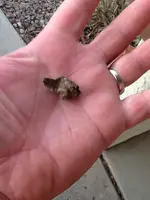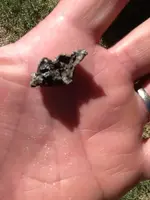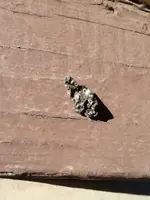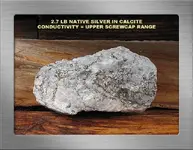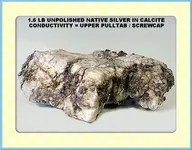You are using an out of date browser. It may not display this or other websites correctly.
You should upgrade or use an alternative browser.
You should upgrade or use an alternative browser.
Silver nugget?
- Thread starter coldgoldblood
- Start date
kazcoro
Hero Member
Looks like a melted bullet, so lead it may be. What part of the state did you find it in?
coldgoldblood
Tenderfoot
- #3
Thread Owner
Found it up on the Mogollon Rim on top of a valley. Found bullets and casings all around the bottom of the valley. It just didn't register the same. My son saved the bullets, I will go back over it again. See if it registers the same.
Jim Hemmingway
Hero Member
Coldgoldblood… your piece has the look of naturally occurring native silver but it could be something else. You might want to check to see if native silver is known to occur in the area where this piece was found.
It is not terribly relevant where the piece target IDs on a metal detector… natural native silver in my area can register in a bench test anywhere from low foil to silver dime range. Where it registers is dependent on size, shape, purity, type of inclusions / alloys, structure, and the profile presented to the coil.
Buried lead bullets / fragments may well exhibit some minor light-hued surface discoloration due to lead oxide formation, whereas the surface of naturally occurring native silver is usually darkened to some extent by tarnish.
Try a quick streak test, and do it outdoors, by running it across a piece of unglazed porcelain. Unfinished bottoms of white coffee mugs will work fine for this test. Silver yields a bright silvery metallic streak whereas lead will produce a grayer streak… and normally a “thicker” streak line because it is softer. As you do this, you’ll “feel” the difference in hardness between silver and lead. Lead is obviously softer and grayer than native silver.
Briskly rub both your nugget and a lead piece with a leather glove. You’ll notice that the “rubbed” area on the silver nugget will remain silvery bright with a high metallic luster that will last many years, whereas the lead will produce a comparatively dull, darker gray appearance. The difference will become more noticeable after a few days as the lead darkens and loses its luster.
There are other more definitive ways to identify silver but these require specialized equipment and / or nitric acid. If still in doubt, I suggest you take it to a jeweler or other specialist, for example a college or district geologist / mineralogist if accessible locally. In fact, once you’ve done these tests you might present that information along with your photos to our fellow member “Dustedyou” under the Hard Rock Mining section of this gold prospecting sub-forum. He is very knowledgeable about minerals, and may be familiar with your area.
The photos below depict native silver found here in Ontario. The first sample has been “rubbed” with a small wire brush attached to a rotary (dremel) tool to remove the gray tarnish that existed prior to cleaning. The second photo has not been similarly cleaned, and it illustrates the heavy sulfide tarnish that often exists on naturally occurring native silver in this area.
Jim.
It is not terribly relevant where the piece target IDs on a metal detector… natural native silver in my area can register in a bench test anywhere from low foil to silver dime range. Where it registers is dependent on size, shape, purity, type of inclusions / alloys, structure, and the profile presented to the coil.
Buried lead bullets / fragments may well exhibit some minor light-hued surface discoloration due to lead oxide formation, whereas the surface of naturally occurring native silver is usually darkened to some extent by tarnish.
Try a quick streak test, and do it outdoors, by running it across a piece of unglazed porcelain. Unfinished bottoms of white coffee mugs will work fine for this test. Silver yields a bright silvery metallic streak whereas lead will produce a grayer streak… and normally a “thicker” streak line because it is softer. As you do this, you’ll “feel” the difference in hardness between silver and lead. Lead is obviously softer and grayer than native silver.
Briskly rub both your nugget and a lead piece with a leather glove. You’ll notice that the “rubbed” area on the silver nugget will remain silvery bright with a high metallic luster that will last many years, whereas the lead will produce a comparatively dull, darker gray appearance. The difference will become more noticeable after a few days as the lead darkens and loses its luster.
There are other more definitive ways to identify silver but these require specialized equipment and / or nitric acid. If still in doubt, I suggest you take it to a jeweler or other specialist, for example a college or district geologist / mineralogist if accessible locally. In fact, once you’ve done these tests you might present that information along with your photos to our fellow member “Dustedyou” under the Hard Rock Mining section of this gold prospecting sub-forum. He is very knowledgeable about minerals, and may be familiar with your area.
The photos below depict native silver found here in Ontario. The first sample has been “rubbed” with a small wire brush attached to a rotary (dremel) tool to remove the gray tarnish that existed prior to cleaning. The second photo has not been similarly cleaned, and it illustrates the heavy sulfide tarnish that often exists on naturally occurring native silver in this area.
Jim.
boulder dash
Jr. Member
Yea looks like my left over ten foil dinner from 1997. Give it a good sniff it it smells like old dinner you have a nice piece of dinner foil
coldgoldblood
Tenderfoot
- #7
Thread Owner
Nope not silver. Did the scratch test. Faded away after a few days. Seems like somebody sho straight into the gound
coldgoldblood
Tenderfoot
- #8
Thread Owner
*shot straight into the ground. Thanks Jim. Best advice on this thread.Nope not silver. Did the scratch test. Faded away after a few days. Seems like somebody sho straight into the gound
Similar threads
- Replies
- 19
- Views
- 867
Users who are viewing this thread
Total: 1 (members: 0, guests: 1)

